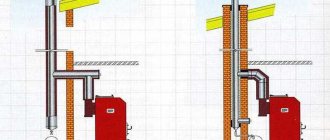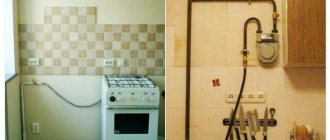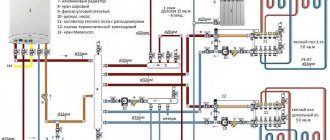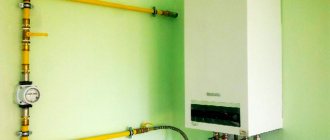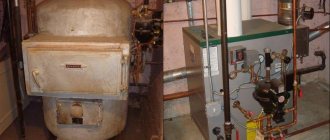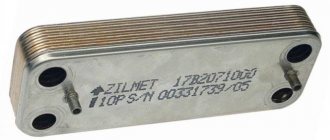A modern chimney is not just a pipe for removing combustion products, but an engineering structure on which the efficiency of the boiler, the efficiency and safety of the entire heating system directly depend. Smoke, backdraft and, finally, fire - all this can occur as a result of an ill-considered and irresponsible attitude towards the chimney. That is why you should take seriously the selection of materials, components and installation of the chimney. The main purpose of the chimney is to remove fuel combustion products into the atmosphere. The chimney creates draft, under the influence of which air is formed in the firebox, which is necessary for the combustion of fuel, and combustion products are removed from the firebox. The chimney must create conditions for complete combustion of fuel and excellent draft. And it must also be reliable and durable, easy to install and durable. And therefore, choosing a good chimney is not as easy as it seems to us.
Requirements for chimneys of gas boilers
Heating with main gas is the most convenient and cheapest (the cost of connection is included in brackets); If the homeowner has the opportunity to install gas into the house, he rarely doubts. But, speaking in the dry language of official interviews, “for the safe operation of gas equipment, the removal of gas combustion products must be ensured, which is why such great importance is given to the proper operation of smoke channels.” Not even the quality of life, but life itself depends on the quality of the chimney of a gas boiler, which is why compliance with the requirements for the smoke ducts of gas boilers is so strictly controlled both in Moscow and in the most remote village.
These requirements are specified in a number of documents, including SNiP 2.04.05, SNiP-91. SP 7.13130.2013 and clause 5.1.1.VDPO. The manufacturer's recommendations are also always taken into account. Here are the main provisions from these documents:
- The draft must be such as to completely remove exhaust gases;
- The chimney must be resistant to high temperatures;
- According to SP 7.13130.2013 Heating, ventilation and air conditioning. Fire safety requirements, the height of the chimney cannot be less than five meters. It should protrude no less than 50 mm above the flat roof; no less than 500 mm - above the roof ridge or parapet (if located at a distance of up to 1.5 m from them); be not lower than the ridge of the roof or parapet (if located at a distance of 1.5-3 m from them) and not lower than a line drawn from the ridge down at an angle of 10° to the horizon (if it is located at a distance of more than 3 m from the ridge.
- If exhaust ventilation ducts are located near chimneys, they should be the same height as these pipes.
- The components of the chimney along its entire length must be sealed, and where it passes through the ceilings the pipe must be solid and without joints;
- The smoke exhaust system must include a condensate collector;
- The wall of the metal pipe is made of high quality alloy steel with an anti-corrosion coating.
During installation work, the following rules are taken into account:
- Each boiler must have a single chimney;
- The height and cross-sectional size of the chimney pipes must be correctly selected for free and complete smoke removal;
- The distance between chimney pipes and surfaces depends on the materials from which these surfaces are made; For non-combustible materials, a gap of 50 mm or more is established, for flammable materials - 25 cm or more.
Mr LeshiyFORUMHOUSE Member
For a gas boiler, 0.5 mm thickness is enough - the main thing is that the steel is grade 300, AISI 304, 316, 321.
- To clean smoke channels from soot, you need recesses of about 250 mm;
- There may be bends on the chimney pipes, but no more than three, their rounding is equal to the diameter of the pipe, there should be inspection hatches at the bends;
- It is recommended to install umbrellas and caps on chimneys.
Region190FORUMHOUSE participant, master inspector at VDPO
Collect condensate. The hatch for cleaning the chimney must be 25 cm lower than the tee (15-20 cm will be accepted, 10 cm will be clever). The acceleration section (straight pipe from the boiler) is at least 700 mm. Smoke turn - no more than three (a tee and two elbows, it is better to have two). The horizontal section is no more than 3 meters. Tee - 90 degrees (not all gas trusts will accept 45, they have their own recommendations and rules and they don’t care what is written in the boiler instructions). The distance of the monopipe from flammable materials is 25 cm, from non-flammable materials is 5 cm; thermal pipes - 5 cm. Do not touch the gas pipe under any circumstances; the chimney - gas duct is at least 5 cm from it!
Types of systems
The design of sauna stoves includes 2 types of chimneys:
- Indigenous. They are organized next to the stove, using a special pipe for connection, through which the smoke goes into the main channel. One chimney can be used for 2-3 stoves. The main thing is that its internal diameter has the appropriate parameters, and the pipes from each heating device are located at different heights;
- Systems with a mounted pipe are mounted directly on the stove pipe and discharged through the roof. This chimney option is the most common for sauna stoves.
Classification of chimneys according to installation location includes 2 types:
- External. Their main part is located on the street and fixed to the wall using a bracket. They are not particularly recommended for baths, as they quickly cool down, losing precious heat.
- Internal. These are vertical structures with good traction, located inside the building.
Depending on the material used, chimneys are:
- Brick. A traditional look, characterized by labor-intensive masonry and high requirements for compliance with all parameters. They have a lot of advantages: durability, fire safety, strength, good thermal insulation and heat accumulation. Disadvantages include the roughness and angularity of the inner surface on which soot deposits accumulate;
- A metal chimney is faster to install and costs less. It has a perfectly smooth surface, but weaker heat-retaining characteristics;
- A combined version, including 2 parts: the lower one is made of brick, the upper one is made of a modern sandwich pipe. Allows you to organize neat, small passages that are easier to cover with heat-resistant material.
The principle of operation of the chimney
As with any heating system, a chimney for a gas boiler is needed to release combustion products into the atmosphere and supply fresh air for complete combustion of the fuel. How it works: in accordance with the law of physics, according to which light warm air tends upward, cold air settles below. Draft in the chimney appears due to the temperature difference: hot gases in the pipe and cold air outside.
If the chimney is installed correctly, it is not only safe, it improves the quality of the boiler’s operation and increases its efficiency, making the microclimate in the house more comfortable.
The chimney for a gas boiler is a complex structure, which includes:
- Smoke exhaust pipe;
- An adapter that connects the pipe and the boiler pipe;
- Branch pipe for passing the chimney through the wall, ceiling, roof;
- Fastening elements;
- Condensate collector;
- A tee with a fitting is necessary for draining condensate;
- Bends.
This is the basic configuration, there may be different variations.
Where to place it?
It is allowed to make a chimney for the boiler inside the house or outside. Both options have their advantages and disadvantages, shown in the table:
| Location | pros | Minuses |
| In the house | Part of the structure in the attic and roof is insulated | Fires and carbon monoxide leaks are more common |
| Outside the building | Safer to use | The entire pipe requires thermal insulation |
| Repair work is easy to do |
Types of chimneys for boilers
There are different types of chimneys that are used in these cases:
A brick chimney is made of fireclay bricks, which are placed either on clay mortar or glue. In most cases, it is made with a stainless or galvanized steel sleeve inside to protect the brick from the destructive effects of carbon dioxide.
Region190FORUMHOUSE participant, master inspector at VDPO
Over time, the brick will begin to crumble due to carbon dioxide, so the chimney must be lined. In the market you can be deceived with the steel grade; it is better to buy AISI 316 directly from the factory. This acid-resistant steel works reliably with any brand of boiler. Not a single inspection master will ask you about the steel grade or demand a certificate; we do not have the authority to do this, and it is impossible to visually distinguish 316 from 425.
The main disadvantage of such a chimney is that it is heavy, you will have to make an additional foundation, and it is bulky, and you will have to look for a stove maker who will lay it out. Previously, such chimneys were often made for gas boilers; now (if funds allow) homeowners prefer ceramics.
Ceramic chimney . This is a complex structure that includes a ceramic smoke exhaust duct, an air layer (or insulation) and an expanded clay concrete shell. Expanded clay concrete protects the fragile ceramic pipe and serves as insulation (and ceramics have high thermal conductivity).
Andrey50FORUMHOUSE member
Cool specialists with extensive experience in chimneys say that ceramics are the best, but unreasonably expensive.
It is much easier to install such a structure than a brick chimney; it is durable, fireproof (can heat up to 120 degrees), but it is also heavy and bulky, and also expensive.
Asbestos-cement chimney. For this type, it is important to have tight joints inside the channels and good insulation to prevent condensation from forming.
RegularUser .FORUMHOUSE
During my construction period, asbestos-cement pipe was the cheapest option. The main problem here is how to hermetically join the segments; I couldn’t get it to be hermetically sealed. Simply pouring concrete is not an option. It should be a sealed sleeve, clamp, insert, anything that provides a reliable and tight connection. Be sure to insulate your asbestos-cement pipes. Do not forget that the design of the chimney should not allow condensate to drain into the boiler and be sure to make a condensate collector at the bottom at the base of the pipe.
Single metal - chimney made of galvanized or stainless steel.
Sandwich chimney. Such a chimney is made of two metal pipes, one is inserted into the other, and insulation is laid between them. Smoke flows through the inner cylinder. This type is required for use as an external chimney and in unheated rooms.
Coaxial. In this chimney, one pipe is inserted into another without laying insulation. But this is a single rigid structure, united by jumpers along its entire length. Smoke exits through the inner pipe, and air enters the combustion chamber through the outer pipe; the room air does not participate in the operation of the gas boiler, the microclimate is maintained.
Mr LeshiyFORUMHOUSE Member
Sandwich is an insulated chimney made of two stainless steel cylinders, between which insulation is stuffed. Coaxial - the same two cylinders, but without insulation inside. Exhaust gases are removed through the inner cylinder to the outside, and air is supplied into the combustion chamber through the gap between the cylinders.
Boiler room
Gas equipment is connected directly to the boiler room. Relative to the house, furnaces can be located:
- inside - built-in;
- nearby on a separate foundation - attached;
- at some distance - separate.
Depending on the location, the premises are subject to certain requirements aimed at ensuring safety during operation.
Built-in
According to SNiP, gas equipment with a power of up to 350 kW is allowed to be installed inside the house. Boilers up to 60 kW can be placed in any room. As a rule, this is a kitchen or domestic premises. More powerful heat generators are located on the first or ground floors, in the basement.
The ceiling in the room should not be lower than 2.5 meters. Ventilation is calculated to replace air three times within an hour, that is, the cross-section of the ventilation ducts should ensure the rate of natural circulation of an amount of air equal to triple the volume of the room.
The size of the window opening minus the sashes must meet the explosion safety requirements. In accordance with it, the area of easily removable structures, in this case glazing, is calculated from the condition of 0.03 m² per 1 cubic meter of room.
When the power of the heating unit is over 150 kW, the room is equipped with a separate exit. Regardless of the characteristics of the boiler, a passage along the front of at least 1 m is left.
Attached premises
An attached boiler room with heating units with a power of up to 350 kW is placed along the blank wall of the house. Set aside at least 1 meter from the nearest door or window opening. The furnace structure should not be rigidly adjacent to the foundation, walls and roof of a residential building.
The material for the walls of the boiler room is selected taking into account the minimum fire resistance limit - 0.75 hours. The structures should not burn or support combustion.
The height of the boiler room inside is at least 2.5 m. The equipment is placed so that it is convenient to service it. The size of the free area in front of the boiler is 1x1 meter.
The attached premises are equipped with a separate exit to the outside. The door should open to the street.
Natural light is a must. The glazing area is at least 0.03 m³ per 1 m³. The hood must support three hourly air exchanges.
The door leading to a residential building is made of fireproof materials. It must comply with the third type of fire safety.
Installing a gas boiler in the kitchen
When installing a gas stove, water heater and boiler with a power of up to 60 kW in the kitchen, the following requirements are imposed on the room:
When installing gas-using equipment, they are guided by the manufacturer’s passport. The walls must be made of fireproof materials, and the distance to the unit must be at least 20 mm.
It is allowed to install boilers near walls made of combustible materials, provided that the surface is protected with a 3 mm thick asbestos sheet and roofing steel or plaster. In this case, at least 30 mm should be removed from the enclosing structures. The insulation is extended beyond the dimensions of the equipment in height and width by 10 and 70 cm.
The floors under the boiler also protect against fire. Sheets of asbestos and metal are laid on them so that their boundaries exceed the dimensions of the body and protrude by 10 cm on all sides.
By condensation or smoke
We must not forget about the main feature of the chimney for a gas boiler: they have high efficiency and a fairly low temperature of the exhaust gases:
Condensation always and quickly forms in the chimneys of a gas boiler.
Therefore, the chimney installation must be done in such a way as to solve the condensation problem. Due to the low temperature of the exhaust gas, chimneys on modern gas boilers are made “through condensate” and not “through smoke”.
VadimProFORUMHOUSE Member
For smoke, this is when the pipe of the lower bend goes inside the pipe of the upper bend, and, accordingly, for condensate - vice versa.
Chimneys for modern gas boilers are collected strictly according to condensate.
This installation method allows condensate to flow calmly down inside the chimney without leaking out (this is dangerous and can cause a fire).
Recommendations from the pros!
Accessories for a bath Do-it-yourself gazebo Concrete fence Do-it-yourself potbelly stove Do-it-yourself veranda Screw foundation Do-it-yourself country toilet Decorative brick Stone fence Pouring a foundation How to make a fence Wicket from corrugated sheets Do-it-yourself fireplace Brick fence Do-it-yourself flower beds Forged gates Do-it-yourself porch Pool for a bathhouse Chicken coop do it yourself DIY staircase Metal gates Installation of lining Installation of polycarbonate Pump for a summer house Arrangement of a garage Fences for flower beds Do-it-yourself blind area Steam room in a bathhouse Railings for stairs Do-it-yourself cellar Painting walls Press with your own hands Grilles on windows Rolling gates Do-it-yourself barn Alarm system for a summer residence Benches for a summer residence Fence posts Floor screed Solid fuel boilers DIY greenhouse Fence installation House insulation Attic insulation Foundation insulation
How to choose the type of chimney
Choosing a gas boiler chimney for our user with the nickname gladiator was not easy, there was too much to consider, and the initial data did not allow us to arrive at the optimal result.
You can lay out a brick chimney and then insert a stainless steel sleeve into it, but according to calculations, a floor made of floor slabs simply will not withstand the load from a brick chimney;
You can install an expensive ceramic chimney system from a well-known one.
You can make a sandwich, but if it’s inside a building, but how can you secure the floors between floors and then not think about what the temperature is there; and how do you know when it’s time to remove the pipes from the wall and change the system? You can make an external chimney, but it would be a pity to spoil the appearance of a private house.
GladiatorFORUMHOUSE Member
Previously, a simple galvanized or brick chimney was made for a gas boiler, but now you don’t know what to choose from.
When choosing a chimney for a gas boiler, experts on our portal recommend taking into account:
- type of combustion chamber, boiler power;
- design features of the house;
- reasonable combination of price and quality.
The choice of boiler depends on the type of gas combustion chamber.
An open firebox is often found in floor-standing gas boilers. Such devices always need good draft, and here a brick and ceramic chimney is preferable; although a sandwich will work too. And we must take into account the design features of the building: a brick chimney is difficult to install and is hygroscopic; and the ceramic chimney is very heavy.
Closed combustion chamber . According to our experts, such devices need a coaxial chimney or sandwich.
The sandwich for a gas boiler looks like a universal model; everyone recommends it.
Alexey TeleginForumHouse user
For gas, a sandwich is ok, but it’s better to make it from acid-resistant 316 steel.
Teplov and SukhovFORUMHOUSE user
For a gas boiler in home use, a sandwich made of 316 steel will last a very, very long time. But change the boiler.
But it is better to choose a chimney for a boiler together with a specialist - this is a more responsible and mature approach. As our experts say, the approach to choosing a chimney system for a gas boiler must be comprehensive, “design/installation/operation” must be taken into account. And it is advisable that everything is done under the guidance of an invited professional.
TraksFORUMHOUSE User
The chimney will be assigned to you by gas workers and reflected in the design. But in addition to a specialist who will accept the completed work, a third-party professional is needed here.
Answers to any complex chimney questions can be obtained here: “Consultations on design standards and rules. If you have any questions about chimneys, just ask.”
Use of wood based on its heat capacity
When choosing a type of firewood, it is worth considering the ratio of cost and heat capacity of a particular wood. As practice shows, the best option can be considered birch firewood, which has the best balance of these indicators. If you purchase more expensive firewood, the costs will be less effective.
To heat a house with a solid fuel boiler, it is not recommended to use types of wood such as spruce, pine or fir. The fact is that in this case, the combustion temperature of the wood in the boiler will not be high enough, and a lot of soot will accumulate on the chimneys.
Firewood made from alder, aspen, linden and poplar also has low thermal efficiency due to its porous structure. In addition, sometimes during the burning process alder and some other types of firewood shoot out coals. In the case of an open furnace, such micro-explosions can lead to fires.
It is worth noting that no matter what the wood is, if it is damp, it burns worse than dry wood and does not burn completely, leaving a lot of ash.
Why insulate a chimney pipe
If the chimney pipe for the boiler is cooled in the cold, then the temperature of the exhaust gases decreases - which means the draft decreases. This problem can be solved by insulating the pipe. How to insulate depends on the material from which the chimney is made:
- Brick structures are plastered, and if the attic is not insulated, then stone or basalt wool with foil on top is used;
- Ceramic chimneys are protected from the cold with mineral wool and ceramic blocks, metal ones are insulated with any non-combustible materials;
- The most difficult thing is with asbestos structures - they can explode if they overheat, so they must be insulated competently and carefully.
Service
How to clean such a chimney?
To clean a horizontal chimney, it is necessary to provide either special doors or areas with knockout bricks. Without these technological holes, it is impossible to clean the snake chimney.
Craftsmen advise periodically heating the stoves with dry aspen firewood and potato peelings.
These methods are not a panacea, but a good way to prevent soot formation.
Gas and smoke: the most important
Here are the most important things to remember when installing a chimney for a gas boiler:
- It has its own characteristics, which are associated with the low temperature of the outgoing smoke, so it must be installed along condensate lines, and a condensate collector must be provided as part of the chimney structures.
- The type of chimney is chosen depending on the power of the boiler and the type of gas combustion chamber; most homeowners like ceramic chimneys, but they are heavy and expensive; Our experts consider sandwiches to be a universal solution, but the quality of the steel is critical here: it should be grade 300, AISI 304, 316, 321.
- Many experts give the following advice: in a private house under construction it is better to provide a ceramic chimney, in an existing one that is connected to a gas pipeline - a steel one;
- The chimney should not come into contact with the gas pipe; a distance of at least 5 cm must be maintained;
- When installing the chimney of a gas boiler in a private house, you must observe all the distances stipulated by regulatory documents (the installation pipe must be no less than 25 cm from flammable materials, and the distance of the thermal pipe from surfaces is 5 cm).
It is recommended for all homeowners to study the regulatory documentation for chimneys, but especially for those who decide to make a chimney with their own hands. Information from our forum on quality criteria for stainless steel chimneys and a thread about a brick chimney system for a gas boiler will help here. Read our article on how to choose a boiler for heating your home. Watch our video on how to properly maintain your chimney to extend its life.
Subscribe to our Telegram channelExclusive posts every week
Video description
How to install a chimney pipe, see the following video:
Connecting a ceramic chimney
Ceramic chimneys themselves are practically eternal, but since this is a rather fragile material, you need to clearly understand how to correctly connect (docking) the metal part of the chimney and the ceramic one.
Docking can only be done in two ways :
- For smoke , a metal pipe is inserted into a ceramic one. It is important to remember here that the outer diameter of the metal pipe should be smaller than that of the ceramic one. Since the thermal expansion of metal is much greater than that of ceramics, otherwise the steel pipe, when heated, will simply rupture the ceramic one.
- For condensate , a metal pipe is placed over a ceramic pipe.
For both methods, specialists use special adapters, which, on one side, are equipped with a gasket for contact with a metal pipe, and on the other, which contacts directly with the chimney, are wrapped in a ceramic cord.
The joining should be carried out through a single-wall pipe - it has a higher heat transfer coefficient. This means that the smoke will have time to cool down a little by the time it reaches the adapter, which ultimately extends the service life of all materials.

